From the Cap’n: Frozen Creeks; Foiled Hunters

Message From the Cap’n is a compilation of fishing advice, waterman and weather insights, Chesapeake lore, and ordinary malarkey from the folks who keep their feet wet in the Potomac and St. Mary’s rivers.
As February opened, the lower Potomac water temperature hovered around 33 degrees Fahrenheit (as checked by thermometer overboard). With the Interpretive Buoy System back online after the government shutdown they again have the full range of up-to-date seawater statistics.
Last week’s cold snap froze up the Island Creek on St. George Island after several days but a warm rain and fog disposed of the thickened water by weeks end. This shallow body of water really freezes fast since the tremendous influx of fresh water which has reduced its salinity.
Observations after the freeze: (prior links but worth repeating) Nippering around the shoreline is always good because the ice pull the oysters out of the bottom. Other sea creatures help as well. Migratory ducks, when looking for food, turn the oysters over on the bottom for the delicacies under them.
Swans, geese, muskrats, raccoons, and otters also move oysters around on the bottom looking for food year round.
“A Tale from years gone by”:
Local Shipwright Francis Goddard tells a story of local watermen using a light to shoot geese in the night-time at Cherryfield. (Cherryfield identifies a southern point of Drayden, MD, that comprises the eastern edge of St. George Creek’s mouth into St. Mary’s River. The map is linked below.)
The equipment used was a 16- to 20-foot skiff, a kerosene lamp mounted in a box with reflectors behind the globe, a sculling paddle, and firearms. The watermen left St. George Island after dark with the tide falling at a point on St. George Island closest to Cherryfield and scull across the channel.
With Francis was Paul Goddard, Ross Clayton, and Gary Robrecht, all local watermen. As Francis tells it:
Two rules apply here: Quietness is of essence and NEVER shoot over the light. The hunting party needed a good sculler. Cap’n Paul Goddard was an expert at this trade and never made a sound. He used a peg at the center of the transom with a rag over it to scull with a flat homemade paddle. The kerosene lamp for the light was lit about 1/2 way across the channel and placed on the bow.
The geese would come ashore on the Edmunds point side of Cherryfield to” get sand for their craws” to grind up their food.
Once we got into shallow water Paul began to push the skiff, making sure that he never made a sound by hitting the side of the boat. As the boat got close to the geese, Paul stopped pushing and drifted toward the geese, keeping the light focused on them. All is quiet and the geese lift their heads, bunch together and swim toward the light.
That’s the way it is supposed to happen.
But Gary rushed a little, shot over the light, and it went out. After much cursing and hell raising the night hunters went home with no geese.
Waterman’s Lore: “Never shoot over the light, ’cause you will blow it out.”
Remember: It’s Our bay, let’s Pass It On
Till next time,
Cap’t Jack
To learn about tours and trips into the Chesapeake, get more information on Fins + Claws’ Leader Member Page




















